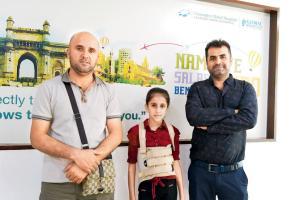After limping for most of her life, an 11-year-old girl from Kurdistan is delighted to be able to walk back home with ease, thanks to the specialised medical treatment she receives in Mumbai

Savya Saman Ali with her uncles, who brought her to Mumbai for the treatment
A rare spinal cord deformation forced Savya Saman Ali, 11, a resident of Kurdistan, Iraq, to limp for most of her life. She is finally able to walk properly now, after receiving medical help in Mumbai.
ADVERTISEMENT
Savya was a kid when her mother noticed that she was limping. Her right leg appeared shorter than the left one, which was initially thought to be the reason for her difficulty while walking. Slowly, she developed scoliosis. She underwent several treatments under paediatricians back home in Kurdistan, but nothing helped. Later, a local neurosurgeon detected the spinal issue through X-rays and spinal MRI. An abnormal block of bone was observed in the centre of her spine, that was causing splitting and tethering of the spinal cord, which led to the development of scoliosis and gait difficulties in Savya.
Referred to Mumbai
However, due to the unavailability of specialists in Kurdistan to treat this condition, she was referred to the Global Hospital in Parel. Dr Suresh Sankhla, head of the neurosurgery department at the hospital said, "This patient has a rare congenital spinal disorder in which her spinal cord is divided into two by a block of bone - a condition known as split cord malformation. Split cord malformation is a less common type of spinal dysraphism [a well-known congenital spinal anomaly with a wide variety of disorders] observed in less than one per cent of children."
Savya had an extreme variety of this malformation. Children with this condition are generally asymptomatic in the early stages but as they grow, the problems caused by spinal tethering become evident in the form of pain, spinal deformities, walking difficulties, paralysis and loss of urine control. This condition generally occurs due to maternal malnutrition or a genetic disorder.
Dr Sankhla added, "She needed to undergo a procedure to micro-surgically remove the intervening bone or fibrous tissue and reconstruct the dural coverings of the spinal cord. This complex surgery on Savya, which lasted for six hours, was successfully performed on July 10. She had an excellent postoperative recovery and was discharged from the hospital on the third day after the surgery."
Slow and steady
However, her scoliosis will completely heal only after dedicated physiotherapy over the next few months. Children whose malformations have been diagnosed and treated early usually recover fully with minimal risk of long-term disabilities, according to experts.
Before flying back to her hometown on July 19, Savya said, "Although I could walk and do daily activities like other children of my age, I was bogged down because they were taller than me. They would walk properly, whereas I would limp. Whenever I asked my mother why I couldn't be like them, she would assure me that things will be fine. Finally, our prayers were heard and I can now walk without limping. My condition is improving and I have been told by the doctors that soon, I will be able to completely get rid of the scoliosis."
Catch up on all the latest entertainment news and gossip here. Also download the new mid-day Android and iOS apps to get latest updates
 Subscribe today by clicking the link and stay updated with the latest news!" Click here!
Subscribe today by clicking the link and stay updated with the latest news!" Click here!






